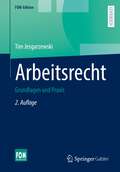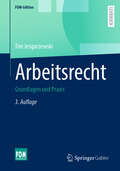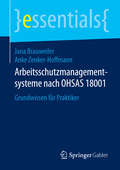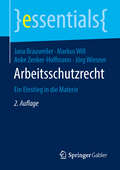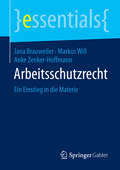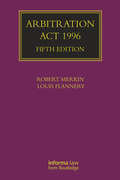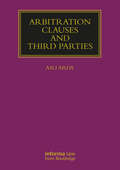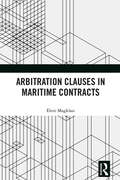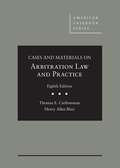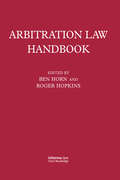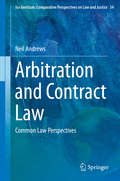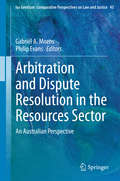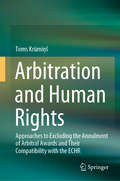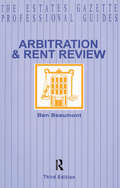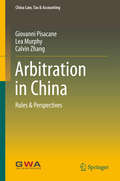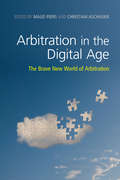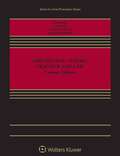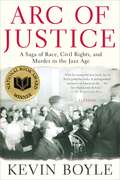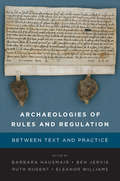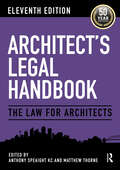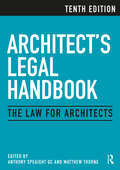- Table View
- List View
Arbeitsrecht: Grundlagen und Praxis (FOM-Edition)
by Tim JesgarzewskiLernen Sie in diesem Buch die Feinheiten des Arbeitsrechts kennen Dieses Buch über das Arbeitsrecht richtet sich an Studierende und Dozenten des Wirtschaftsrechts und der BWL. Durch seinen hohen Praxisbezug eignet es sich ebenfalls für Führungskräfte in Unternehmen. Das Buch gibt einen Überblick über die Grundlagen des Arbeitsrechts, der Ihnen hilft, juristische Probleme in Zukunft eigenständig zu bewältigen. Neben dem Kollektivarbeitsrecht (z.B. in Bezug auf Gewerkschaften) behandelt das Buch Fragen des Individualarbeitsrechts, wie etwa zum Arbeitsschutzrecht und erläutert die rechtlichen Grundlagen eines Arbeitsverhältnisses. Damit hilft dieses Standardwerk nicht nur beim Lösen von Klausurfragen, sondern auch bei der Umsetzung von Vorschriften des Arbeitsrechts im eigenen Betrieb.
Arbeitsrecht: Grundlagen und Praxis (FOM-Edition)
by Tim JesgarzewskiDieses Buch hilft Ihnen, das Arbeitsrecht besser zu verstehen Dieses Lehrbuch bietet einen umfassenden Überblick über die Grundzüge des Arbeitsrechts. Im Vordergrund steht der Praxisbezug, der einen schnellen Einstieg in die für die Wirtschaft wesentlichen Anwendungsfälle des Rechts gewährleistet. Tim Jesgarzewski vermittelt fundiertes Basiswissen, mit dem Sie rechtliche Probleme selbstständig formulieren und lösen können. Da in zunehmendem Maße selbst einfache unternehmerische Sachverhalte rechtlich überprüft werden müssen, sind juristische Kenntnisse für Führungskräfte unverzichtbar. Darum richtet sich dieses Buch an Entscheider in Unternehmen und an Studierende und Dozierende der Betriebswirtschaft und des Wirtschaftsrechts. Darüber hinaus eignet es sich zur Klausurvorbereitung und als Arbeitshilfe. Das Buch behandelt alle Facetten des Arbeitsrechts Der Leser erhält einen umfangreichen Überblick über die Grundkenntnisse des Arbeitsrechts. Dazu gehören unter anderem: Rechtliche Grundlagen des Arbeitsverhältnisses Kollektivarbeitsrecht Individualarbeitsrecht Während der Autor zunächst auf die Geschichte des Arbeitsrechts und die Abgrenzung zu anderen Rechtsgebieten eingeht, erläutert er im Folgenden die rechtlichen Grundlagen eines Arbeitsverhältnisses. Daneben beschäftigt sich das Arbeitsrecht-Buch mit dem Kollektivarbeitsrecht. Tim Jesgarzewski zeigt, welche Rechte Arbeitergemeinschaften zustehen, zum Beispiel in Bezug auf Gewerkschaften. Anschließend geht er auf die Vorschriften des Arbeitsrechts des Einzelnen ein. Dazu gehören Thematiken wie: Urlaubsrecht Inhaltskontrolle des Arbeitsvertrages Diskriminierungsschutz im Arbeitsverhältnis Entgeltfortzahlung Betriebliche Altersversorgung Arbeitsschutzrecht Prozessrecht In der 3. Auflage wurden die aktuelle Gesetzeslage sowie die in der Zwischenzeit ergangene Rechtsprechung berücksichtigt.
Arbeitsschutzmanagementsysteme nach OHSAS 18001: Grundwissen für Praktiker (essentials)
by Jana Brauweiler Anke Zenker-HoffmannJana Brauweiler und Anke Zenker-Hoffmann stellen in diesem Essential Anforderungen an Arbeitsschutzmanagementsysteme (AMS) nach der Occupational Health Safety Assessment Series 18001 (OHSAS 18001) vor. Die Autorinnen definieren Begriffe und systematisieren die vorhandenen Konzepte zur Einführung eines AMS nach Gestaltungsebenen. Da von den Konzepten die internationale Norm OHSAS 18001 in der internationalen Verbreitung eine führende Rolle einnimmt, erläutern sie an diesem Beispiel ausführlich die Anforderungen an ein AMS nach den Phasen des Managementkreislaufes plan-do-check-act und unterlegen diese, wo möglich, mit Beispielen.
Arbeitsschutzrecht: Ein Einstieg in die Materie (Essentials)
by Jana Brauweiler Markus Will Anke Zenker-Hoffmann Jörg WiesnerJana Brauweiler, Markus Will und Anke Zenker-Hoffman stellen den umfangreichen und heterogenen Themenbereich des Arbeitsschutzrechts in Deutschland übersichtlich und kompakt vor. Sie erlauben es dadurch dem Leser, sich schnell einen Überblick zu verschaffen oder wesentliche Aspekte des Arbeitsschutzrechts, das in Deutschland im dualen System geregelt und überwacht wird, zu wiederholen. Während staatliche Einrichtungen für die Gesetzgebung und deren Umsetzung in Form von Verordnungen, Verwaltungsvorschriften und Erlassen zuständig sind, erlassen Berufsgenossenschaften ergänzend dazu Unfallverhütungsvorschriften und konkretisierende Durchführungsanweisungen. Abschließend gehen die Autoren auch auf Haftungsfragen unterschiedlicher Mitarbeitergruppen ein.
Arbeitsschutzrecht: Ein Einstieg in die Materie (essentials)
by Jana Brauweiler Markus Will Anke Zenker-HoffmannJana Brauweiler, Markus Will und Anke Zenker-Hoffman stellen den umfangreichen und heterogenen Themenbereich des Arbeitsschutzrechts in Deutschland übersichtlich und kompakt vor. Sie erlauben es dadurch dem Leser, sich schnell einen Überblick zu verschaffen oder wesentliche Aspekte des Arbeitsschutzrechts, das in Deutschland im dualen System geregelt und überwacht wird, zu wiederholen. Während staatliche Einrichtungen für die Gesetzgebung und deren Umsetzung in Form von Verordnungen, Verwaltungsvorschriften und Erlassen zuständig sind, erlassen Berufsgenossenschaften ergänzend dazu Unfallverhütungsvorschriften und konkretisierende Durchführungsanweisungen. Abschließend gehen die Autoren auch auf Haftungsfragen unterschiedlicher Mitarbeitergruppen ein.
Arbeitswelt und KI 2030: Herausforderungen und Strategien für die Arbeit von morgen
by Inka Knappertsbusch Kai GondlachIn zehn Jahren wird die Zusammenarbeit mit künstlicher Intelligenz (KI) für uns selbstverständlicher sein als der Einsatz von Mobiltelefonen heute. 78 anerkannte Experten aus Praxis und Forschung gewähren tiefe Ein- und Ausblicke bezüglich des Einflusses von KI auf den Arbeitsalltag im Jahr 2030. Sie erläutern anhand von Praxistipps, wie Sie sich auf diese Entwicklung vorbereiten können.Die 41 prägnanten Beiträge decken ein breites Spektrum in dem jeweils untersuchten Bereich ab. Sie beinhalten dank einer standardisierten Struktur eine Zusammenfassung des Status Quo, konkrete Beispiele, zukünftige Erwartungen, einen Überblick über Herausforderungen und Lösungsansätze sowie praktische Tipps.Der Band beginnt mit gesellschaftlichen und ethischen Aspekten, bevor rechtliche Gesichtspunkte für Arbeitgeber und Personalverantwortliche sowie die Justizverwaltung erörtert werden. Die weiteren Kapitel untersuchen die Auswirkungen von KI auf die Arbeitswelt im Jahr 2030 in den Branchen Wirtschaft, Industrie, Mobilität und Logistik, Medizin und Pharmazie sowie in der (Aus-)Bildung.
Arbitration Act 1996: An Annotated Guide (Lloyd's Arbitration Law Library)
by Robert Merkin Louis FlanneryThis book is an essential resource for any legal practitioner involved in any aspect of English arbitration law. It provides a thorough annotation of the Arbitration Act 1996, and contains comprehensive explanations of developments in the relevant case law to each section of the Act.Since the fourth edition of this book, the English courts have decided many important new cases on virtually every aspect of arbitration law. The most important developments relate to: The growth of anti-arbitration injunctions; The use of freezing injunctions against third party assets and the availability of anti-suit injunctions in EU proceedings; The definition of seat, the appointment of arbitrators, choice of applicable law, jurisdiction, the form of the award and the slip rule; Enforcement of foreign awards, and challenges to domestic awards by way of jurisdictional attacks, serious irregularity or error of law In this 5th edition, the notes to each section contain helpful sub-headings and a new Appendix will contain a fully annotated version of CPR Part 62 and the Practice Direction. The book will also be useful for academics and university students of law at all levels seeking an understanding of the 1996 Act, including those on the Legal Practice Course.
Arbitration Clauses and Third Parties (Lloyd's Arbitration Law Library)
by Asli ArdaThis is the first book to focus on the legal question of the incorporation of arbitration clauses, even though this issue constitutes a common problem that arises frequently in practice. Arbitration Clauses and Third Parties compares different branches of law, namely shipping, reinsurance, and construction, where the legal notion of incorporation is often implemented. It evaluates how the differences and peculiarities of the said branches of law impact the outcome of the incorporation of arbitration clauses and therefore why a ‘one size fits all’ approach should be avoided. The book provides both an in-depth legal analysis of the incorporation of arbitration clauses as well as the legal position of the third parties regarding arbitration agreements and a detailed evaluation of the relevant case law. It further offers a unique comparative analysis of English law and Singapore law with regards to the incorporation of arbitration clauses and features recent case law on the issue from both jurisdictions. Moreover, the book explores the status of third parties to arbitration and a wide range of legal situations in which arbitration clauses bind third parties. This book will be directly of interest to lawyers and professionals in arbitration, reinsurance, construction, and shipping, as well as to relevant academic courses.
Arbitration Clauses in Maritime Contracts
by Eleni MagklasiArbitration clauses are sacrosanct in maritime contracts. Standard forms of charterparties and bills of lading reflect a desire to trade over the trusted dispute resolution choice of arbitration. However, when incorporating arbitration clauses, disputes and interpretational complexities continue to arise evidencing that the law is not settled yet. This book introduces a holistic evaluation of the commercial reasons and the legal principles that permeate the incorporation of arbitration clauses in modern maritime contracts, contrasting arbitration with exclusive jurisdiction clauses, where appropriate.The book presents a modern specialised legal study of incorporation of arbitration clauses into maritime contracts, considering recent developments and long-established principles of incorporation.Offering a thorough research into English, European, and Chinese law, with the objective to assess how the incorporation of arbitration principles crystallises through the years, the book will be of interest to researchers, legal practitioners, and commercial parties.
Arbitration Law And Practice (American Casebook)
by Thomas Carbonneau Henry BlairThe Eighth Edition of this popular casebook fully integrates the most recent SCOTUS cases, including Epic Systems v. Lewis and Kindred Nursing Centers, Ltd. Partnership v. Clark, as well as a number of significant lower court decisions from the last three years. To keep pace with the rapid evolution of arbitration law, the new edition refines its organization to more precisely define issues of critical importance while retaining comprehensive coverage. In particular, the early chapters have been revised to provide pinpoint articulation of the core concepts and principles of arbitration law. Meanwhile, the later chapters on fairness in arbitration and enforcement of arbitral awards have been expanded and reworked to account for current trends in the decisional law. As with prior editions, this volume aims to be a teaching tool, allowing students and instructors to comprehensively assess the defining work of the Supreme Court while predicting when, why, and how the law will continue to change.
Arbitration Law Handbook
by Roger Hopkins Benjamin HornThe Arbitration Law Handbook collects together in one volume the laws in force in more than twenty countries, with the main procedural rules used in each of those countries. Each section has a short overview identifying relevant treaty obligations, the main arbitral bodies and the principal laws in force. Additionally, there is an international section in which the UNCITRAL Model Law and Arbitration Rules are set out and in which the major international conventions relating to arbitration, such as the New York Convention and table of signatories, are reproduced. The section also includes the ICSID Arbitration Rules (applicable to the settlement of investment disputes), as well as those of WIPO (applicable to the settlement of intellectual property disputes)
Arbitration Law in America
by Edward Brunet Richard E. Speidel Jean R. Sternlight Stephen J. WareArbitration Law in America: A Critical Assessment is a source of arguments and practical suggestions for changing the American arbitration process. The book, first published in 2006, argues that the Federal Arbitration Act badly needs major changes. The authors, who have previously written major articles on arbitration law and policy, here set out their own views and argue among themselves about the necessary reforms of arbitration. The book contains draft legislation for use in international and domestic arbitration and a detailed explanation of the precise justifications for proposed legislative changes. It also contains two proposals that might be deemed radical - to ban arbitration related to the purchase of products by consumers and to prohibit arbitration of employment disputes. Each proposal is vetted fully and critiqued by one or more of the other co-authors.
Arbitration and Contract Law: Common Law Perspectives (Ius Gentium: Comparative Perspectives on Law and Justice #54)
by Neil AndrewsThisbook deals with the contractual platform for arbitration and the application ofcontractual norms to the parties' dispute. Arbitration and agreement areinter-linked in three respects: (i) the agreement to arbitrate is itself acontract; (ii) there is scope (subject to clear consensual exclusion) inEngland for monitoring the arbitral tribunal's fidelity and accuracy inapplying substantive English contract law; (iii) the subject-matter of thearbitration is nearly always a 'contractual' matter. These three elementsunderlie this work. They appear as Part I (arbitration is founded onagreement), Part II (monitoring accuracy), Part III (synopsis of the Englishcontractual rules frequently encountered within arbitration). Thebook will be a useful resource to foreign lawyers or English non-lawyers,English lawyers seeking a succinct discussion, and to arbitral tribunals.
Arbitration and Dispute Resolution in the Resources Sector: An Australian Perspective (Ius Gentium: Comparative Perspectives on Law and Justice #43)
by Philip Evans Gabriël A. MoensThis book provides a comprehensive Australian perspective on the resolution of resources disputes. In particular, it focuses on the use of arbitration, mediation and adjudication in the resources sector. It concentrates on arbitration as the preferred method of dispute resolution, including international commercial and investor-state arbitration. The book offers fascinating insights into the use of arbitration to investment disputes involving resources companies in the African OHADA countries, Australia and other countries. It offers an Australian perspective which will be useful to discerning arbitration scholars and dispute resolvers. In addition, the book provides useful information on how to draft arbitration clauses for resources sector contracts. This publication will be of interest to members of the academic research community and will also appeal to dispute resolution professionals and practitioners.
Arbitration and Human Rights: Approaches to Excluding the Annulment of Arbitral Awards and Their Compatibility with the ECHR
by Toms KrūmiņšThis book presents a creative synthesis of two ostensibly disparate fields of law – arbitration and human rights. More specifically, it focuses on various legislative approaches to excluding the annulment of arbitral awards (setting-aside proceedings) at the seat of arbitration and evaluates the compatibility of such approaches with the European Convention on Human Rights (ECHR), in particular the right to a fair trial under Article 6(1). The book first assesses the applicability and impact of the ECHR, in particular Article 6(1), on international commercial arbitration. It then analyses a number of legislative approaches to excluding setting-aside proceedings, focusing on two synergetic phenomena – exclusion agreements and the total lack of setting-aside proceedings in national arbitration law. Lastly, the book investigates to what extent the lack of setting-aside proceedings in national arbitration law may lead to a violation of arbitrating parties’ right to a fair trial under Article 6(1), and puts forward certain de lege ferenda recommendations on how to best approach the regulation of setting-aside proceedings in national arbitration law from the standpoint of compliance with the ECHR.
Arbitration and Rent Review
by Ben BeaumontArbitration and Rent Review has become a standard work in the property world for guidance on rent review. In a clear style, the author examines the procedures that landlord and tenant should follow in order to agree a new rent or to have one decided by arbitration. By means of cases, he highlights the key areas of conflict that come before the courts, the contentious issues being introduced in the order in which they would be encountered by landlords or tenancts facing a review.
Arbitration and the Constitution
by Peter B. RutledgeArbitration has become an increasingly important mechanism for dispute resolution, both in the domestic and international setting. Despite its importance as a form of state-sanctioned dispute resolution, it has largely remained outside the spotlight of constitutional law. This landmark work represents one of the first attempts to synthesize the fields of arbitration law and constitutional law. Drawing on the author's extensive experience as a scholar in arbitration law who has lectured and studied around the world, the book offers unique insights into how arbitration law implicates issues such as separation of powers, federalism, and individual liberties.
Arbitration in China: Rules & Perspectives (China Law, Tax & Accounting)
by Giovanni Pisacane Lea Murphy Calvin ZhangThe book provides a comprehensive and practical overview of arbitration in the People's Republic of China. The process of arbitrating a dispute is described from the perspective of a non-Chinese individual or business. Readers are guided through the typical course of events in an arbitration process. By avoiding both excessive technicality and undue simplification, the book appeals to both law professionals and business managers, and is useful for practitioners and non-experts alike. Recent developments in Chinese law on the matter, up to the first quarter of 2015, has been taken into account in order to provide readers with a pragmatic, up-to-date presentation of the topic. For the same reasons, illustrative reference is made to the Shanghai FTZ Arbitration Rules. The relevant provisions are noted throughout the text; the three appendices at the end of the book allow for easy referencing of the main legislation and regulations. The appendices include English versions of the most important PRC Statutes and Interpretations of Statutes on arbitration, the Arbitration Rules of the main Chinese arbitration institutions and the official Model Arbitration Clauses suggested by those institutions.
Arbitration in the Digital Age: The Brave New World of Arbitration
by Maud Piers Christian AschauerArbitration in the Digital Age analyses how technology can be efficiently and legitimately used to further sound arbitration proceedings. The contributions, from a variety of arbitration scholars, report on current developments, predict future trends, and assesses their impact from a practical, legal, and technical point of view. The book also discusses the relationship between arbitration and the Internet and analyses how social media can affect arbitrators and counsel's behaviour. Furthermore, it analyses the validity of electronic arbitration and awards, as well as Online Arbitration (OArb). The volume establishes, on a very practical level, how technology could be used by arbitration institutions, arbitrators, parties to an arbitration and counsel. This book will be of special interest to arbitrators and lawyers involved in international commercial arbitration.
Arbitration: Theory, Practice and Law
by Jay Folberg Dwight Golann Thomas J. Stipanowich Lisa A. KloppenbergThis custom title contains selections from: <p><p> Resolving Disputes: Theory, Practice, and Law, Third Edition (9781454838746); Jay Folberg, Dwight Golann, Thomas J. Stipanowich, Lisa A. Kloppenberg
Arc of Justice: A Saga of Race, Civil Rights, and Murder in the Jazz Age
by Kevin BoyleAn electrifying story of the sensational murder trial that divided a city and ignited the civil rights struggle<P><P> In 1925, Detroit was a smoky swirl of jazz and speakeasies, assembly lines and fistfights. The advent of automobiles had brought workers from around the globe to compete for manufacturing jobs, and tensions often flared with the KKK in ascendance and violence rising. Ossian Sweet, a proud Negro doctor-grandson of a slave-had made the long climb from the ghetto to a home of his own in a previously all-white neighborhood. Yet just after his arrival, a mob gathered outside his house; suddenly, shots rang out: Sweet, or one of his defenders, had accidentally killed one of the whites threatening their lives and homes. <P> And so it began-a chain of events that brought America's greatest attorney, Clarence Darrow, into the fray and transformed Sweet into a controversial symbol of equality. Historian Kevin Boyle weaves the police investigation and courtroom drama of Sweet's murder trial into an unforgettable tapestry of narrative history that documents the volatile America of the 1920s and movingly re-creates the Sweet family's journey from slavery through the Great Migration to the middle class. Ossian Sweet's story, so richly and poignantly captured here, is an epic tale of one man trapped by the battles of his era's changing times.<P> Arc of Justice is the winner of the 2004 National Book Award for Nonfiction.<P>
Archaeologies of Rules and Regulation: Between Text and Practice
by Barbara Hausmair Ben Jervis Ruth Nugent Eleanor WilliamsHow can we study the impact of rules on the lives of past people using archaeological evidence? To answer this question, Archaeologies of Rules and Regulation presents case studies drawn from across Europe and the United States. Covering areas as diverse as the use of space in a nineteenth-century U.S. Army camp, the deposition of waste in medieval towns, the experiences of Swedish migrants to North America, the relationship between people and animals in Anglo-Saxon England, these case studies explore the use of archaeological evidence in understanding the relationship between rules, lived experience, and social identity.
Archaeologies of Rules and Regulation: Between Text and Practice
by Eleanor Williams Barbara Hausmair, Ben Jervis, Ruth NugentHow can we study the impact of rules on the lives of past people using archaeological evidence? To answer this question, Archaeologies of Rules and Regulation presents case studies drawn from across Europe and the United States. Covering areas as diverse as the use of space in a nineteenth-century U.S. Army camp, the deposition of waste in medieval towns, the experiences of Swedish migrants to North America, the relationship between people and animals in Anglo-Saxon England, these case studies explore the use of archaeological evidence in understanding the relationship between rules, lived experience, and social identity.
Architect's Legal Handbook: The Law for Architects
by Anthony Speaight Matthew ThorneCelebrating 50 years since it was first published, the Architect’s Legal Handbook has been the most widely used reference on the law for practicing architects, and the established textbook on law for architectural students. Since the last edition of this book in 2021, unprecedented change has occurred in the construction sector. The withdrawal of the United Kingdom from the European Union has ushered in changes to legislation in a wide range of areas. The tragic fire at Grenfell Tower in June 2017 and the deficiencies in design, construction, and regulation within the sector that were revealed as a result have given rise to major changes in the way projects are now carried out. An overhaul of the Building Regulations and the creation of a new Building Safety Regulator are only some of the ways in which the landscape has changed. This eleventh edition features all the latest developments in the law which affect an architect’s work, as well as providing comprehensive coverage of relevant UK law topics. Key highlights of this edition include: A new chapter has been added to cover the statutory framework for building safety (Chapter 9), which is complemented by a wholly updated chapter on construction regulation in England and Wales (Chapter 10). The chapter on public procurement law (Chapter 14) has also been entirely rewritten to focus on the Public Procurement Act 2023 and related regulations, following Brexit. New suites of standard contract forms have, since the last edition, been issued. These have seen substantial changes with chapters on JCT 2024 (Chapter 18) and the latest NEC4 forms (Chapter 19), together with wider updates to the chapters on FIDIC (Chapter 20) and other forms of contract (Chapter 21). A revised chapter on architects’ contracts with clients covering the RIBA Professional Services Contract 2024 (Chapter 37). A new section on novations in the chapter on the English Law of Contract (Chapter 2). The Architect’s Legal Handbook is the essential legal reference work for all architects and students of architecture.
Architect's Legal Handbook: The Law for Architects
by Anthony Speaight QC and Matthew ThorneThe Architect's Legal Handbook is the most widely used reference on the law for practicing architects and the established textbook on law for architectural students. Since the last edition of this book in 2010, the legal landscape in which architecture is practised has changed significantly: the long-standing procurement model with an architect as contract administrator has been challenged by the growing popularity of design and build contracts, contract notices in place of certificates, and novation of architect’s duties. The tenth edition features all the latest developments in the law which affect an architect's work, as well as providing comprehensive coverage of relevant UK law topics. Key highlights of this edition include: an overview of the legal environment, including contract, tort, and land law; analysis of the statutory framework, including planning law, health and safety, construction legislation, and building regulations in the post-Grenfell legal landscape; procurement and the major industry construction contract forms; building dispute resolution, including litigation, arbitration, adjudication, and mediation; key fields for the architect in practice, including architects’ registration and professional conduct, contracts with clients and collateral warranties, liability in negligence, and insurance; entirely new chapters on various standard form contracts, architects’ responsibility for the work of others, disciplinary proceedings, and data protection; tables of cases, legislation, statutes, and statutory instruments give a full overview of references cited in the text. The Architect’s Legal Handbook is the essential legal reference work for all architects and students of architecture.
